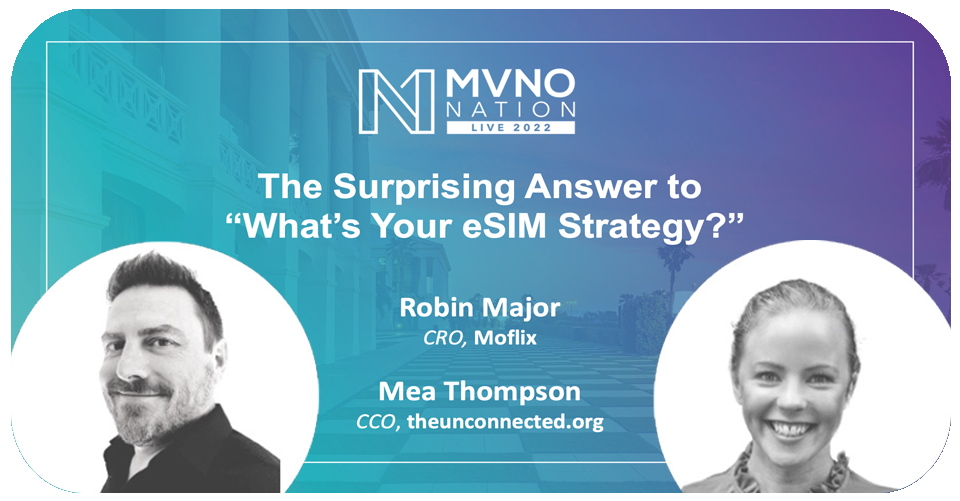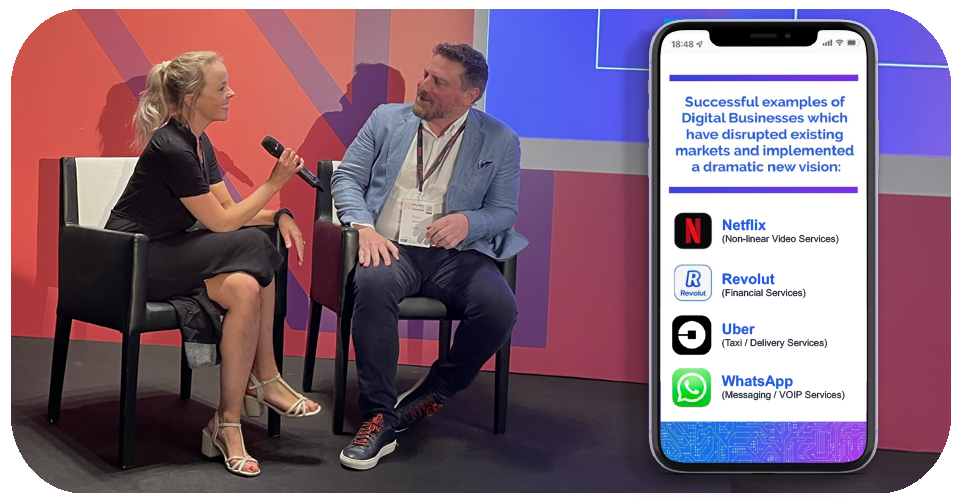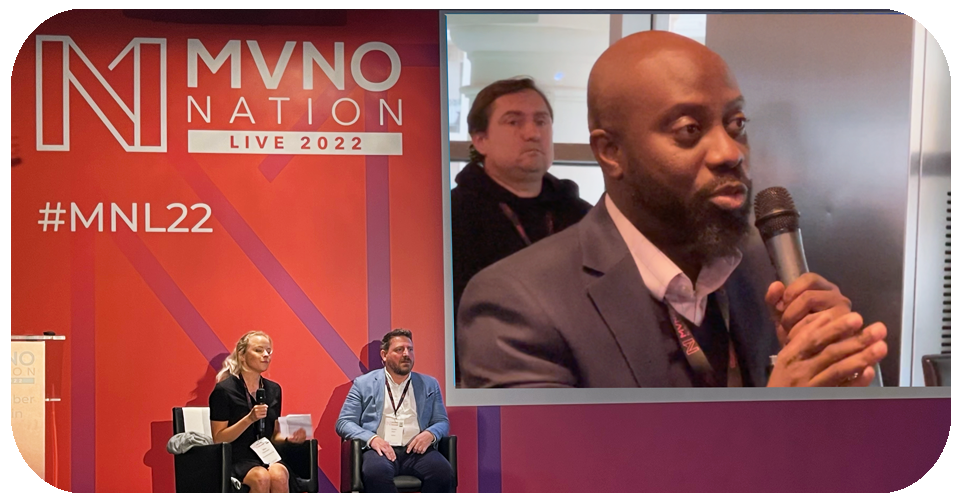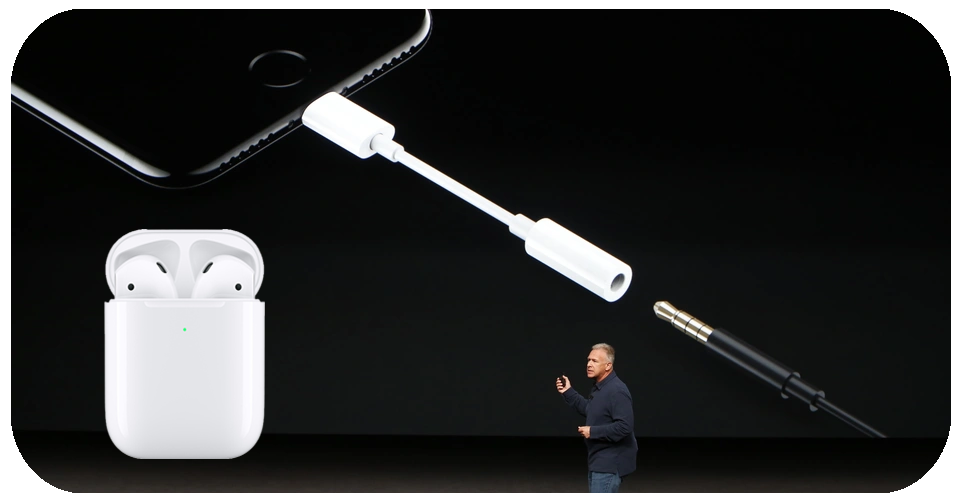The Surprising Answer to "What's Your eSIM Strategy?" from MVNOs

Not your typical eSIM discussion. Moflix CRO Robin Major and eSIM guru Mea Thompson debate "Did Apple Jump the Gun with an eSIM-only USA iPhone14" at MVNO Nation Live, and bluntly discuss everything eSIM and how MVNOs can leverage this disruptive capability to bring All Digital propositions to life, and accelerate their path to value.
Download PDF Transcript of Full Session
MEA
We are going to talk about eSIM, and we are going to do things slightly differently. You won’t see many statistics. You won’t see any big numbers. We’re literally going to have a heart-to-heart conversation about eSIM, how to launch eSIM, what are the issues that an MNVO faces to launch eSIM and whose responsibility is it to fix it.
Let's start with some intros. My name is Mea Thompson. I have worked in the eSIM industry for seven years, so I've been with it for a while. I've been to a lot of MVNO conferences, and I've listened to a lot of eSIM talks. So, we thought we'd make this one slightly different. And with me on stage, who I'm interviewing today is Robin Major.
ROBIN
Yeah, hi everybody. My name is Robin Major. I'm the Chief Revenue Officer of Moflix Group, which is a company based primarily in Finland. And we were brought into being to help telcos really think about the way that we need to do business in the 21st century to service the 21st-century consumer with the thought process that if you were to start a telco in 2022, what would it look like? And the answer is probably very different to what it would look like in 1992 when I suspect many of the people in this room started rolling out mobile services to their customers.
Really, what Moflix is giving the community is an All Digital Telco in an App that's ready to roll in less than 100 days. And through the lens of the customer, is important to enable them to consume telco services with the low friction ways of onboarding and interacting with the operator that we've become used to from many other service providers in other industries, whether that be Uber in the ride service sector, whether that be Revolut in the mobile banking sector. We've all become very used to just being able to download an app, sign up for a service, and then continue to use it with very little hassle.
The mobile industry has made that difficult for us to do. WhatsApp is a really good example of how easy it is to sort of download and onboard for telecommunications service. And it's our firm belief that we as the MVNO community should be leading the way in disrupting that thought process and that market engagement and sharing the way with the rest of the mobile industry.

The reason we're on the stage talking about eSIM is we received an award earlier this year as the ”Consumer eSIM Solution of the Year”, together with one of our customers, which is NiceMobil in Norway. And the good folks at MVNO Nation here were kind enough to interview us about it and hence we’re on stage talking about it today.
MEA
Great intro. Okay, so let's look back on the eSIM industry without being boring. I've been speaking about eSIM on stage here since 2017. A lot has changed, but I'm still not that impressed with the progress and again, this is going to be an honest discussion, so let's keep it honest.
So, looking back from your experience, what have you seen happening with eSIM? If you look back in a few years, what has been the progression in your sense?
ROBIN
It's a really good question. I think eSIM was launched as a set of specs in, what, 2016? The first devices we saw coming out in 2017 to great fanfare about how this was going to revolutionize the industry. And I think if we're all honest with ourselves, the sort of the penetration of eSIM as a vehicle for making it easier for customers to take advantage of mobile services or to switch between them - that penetration has been a lot slower than I think any of us would have expected. There are a bunch of different reasons for that, which I think we're going to get into in a bit more in the conversation.
I've personally spent the last ten years working with telcos, either as MVNOs or as the sub-brands of MNOs themselves, helping launch these kinds of All Digital Telco-in-an-App propositions. And there's no doubt we've seen more interest in that space, using eSIM as a way of acquiring customers, disrupting markets, rapidly increasing market share, and for others an enabler to really give that sort of WhatsApp ease of onboarding and management of the experience. There is no doubt it's a really powerful tool in the toolkit that operators have. But we really haven't seen it reach its full potential in the last five years. And it will be interesting to see whether some of the announcements we've seen in the market in the last couple of months are going to change that in a dramatic way.
MEA
And I agree with you in many ways. So, I still get shocked when I speak to big MVNOs in the market and I'm kind of like sucked into the eSIM zone. So, my questions are always something like, ”What's your eSIM strategy? Have you launched eSIM? What do you think about eSIM? Is your host operator eSIM ready?”
And I can’t count the number of times that MVNOs answer me, ”Oh, well, we're going to get to that. We're looking at Q3 next year”.
And I'm like, “Really? Like, have you seen where the market is going?”
And maybe it's just because I'm so into eSIM. It's good for you guys in the audience - If you don't agree with me, totally fine. Do ask questions when we call it out.
Okay, Robin, when you talk to operators as you do daily, some of them have no clue about eSIM, others want to do it - but maybe they can't because their operators in some cases can't provide them with that service. What do you think are the top use cases for the MVNOs?
Why do they want to launch eSIM?
ROBIN
Yeah, well, I think there are a bunch of different reasons that people are looking at eSIM. I'd like to think that eSIM is going to become the mainstream vehicle for customers onboarding with mobile subscriptions. The reality is that we're a long way from being there yet.
And I think what we're seeing is a few corner cases - with apologies to the operators that run these kinds of business where they are not corner cases, they're absolutely core to their business!
But in terms of the mass market of mobile, we're seeing edge cases like Travel use cases where people are using eSIM as a vehicle for giving people easy access to a local mobile number and data when they come abroad, or when they travel to a part of the world that's outside of an inclusive roaming agreement, and that's replacing the idea of the SIM store at the airport model.
We're obviously seeing eSIM being evaluated as a potential vehicle for mass deployment in things like IoT and M2M use cases. I think for me, the big one that's yet to be cracked properly is having eSIM really as a universal vehicle for enabling customers to onboard quickly, for disruptive operators like MVNOs to get to value quickly and not have to be dependent on large-scale logistics to be able to distribute plastic and manage the disposal of those legacy SIMs subsequently as well.
So those are sort of the cases that I think we're seeing at the moment. It'd be very interesting to get some sense from the community whether there are other things out there that we haven't been considering yet.
MEA
Yeah. And I think this might be a good time to ask you guys because it's been a long day. I've had coffee, but not enough, and I haven't started drinking wine yet.
What other use cases do you see for eSIM that you think are extra interesting? Are there any use cases that we didn't cover that you think "This is key for us?"
AUDIENCE MEMBER 1
Yes. Hi. I'm from the UK. And I think one of the fundamental questions (and also I think it's a very popular stat from GSMA) about the fact that when you ask about consumers, ”What's eSIM?” I think from the story is about 20% have heard about eSIM, whereas when you talk about 5G, there's a lot.
The first question people ask is, ”What is eSIM?” Because when you say eSIM, they think electronic, see? But then when you say embedded SIM, they really don't understand the concept

So the question is, why is it so difficult in the B2C space for consumers to really grasp the concept of eSIM? And I know this discussion is around whether Apple jumped the gun by something fundamental that’s a lot about awareness and education. We have a bias because for some reason - people just don't really understand it. (When I say people, I mean people outside of our industry…. Consumers).
Because we're in the travel space (in mobile), and that's what we're trying to tap into. But part of the research we've done is that people are not really getting it… so part of what we need to do is actually educate them. Then it's about finding that good balance in terms of what do we say really resonates. That makes sense.
MEA
That's a really interesting question, and that falls well under the theme as well. And that brings us to another question of how do we educate the general public about eSIM and who is responsible for educating the public.
So, if we see it as a triangle, it would be the OEMS, the public, and the Operators. And if two of the corners are moving, then we can see the third corner having to move. And I think the OEMs have really started to move which has forced the Operators to move, which is now getting the third corner of the public to move.
That was a great question.
ROBIN
That was a great question. And is jumping ahead to what we wanted to talk about later as well. Within this industry, nothing happens unless you market it and throw some money at educating people about what is possible. We are going to be talking about Apple quite a bit in this conversation.
If you look at pre-2007 and post-2007 - pre-2007 there were plenty of touchscreen devices available in the market that were being pushed as smartphones. They were being made by OEMs like HTC on behalf of Microsoft and Nokia had its fingers in the fire playing around with touchscreen technology.
But it wasn’t until Apple really hit the ground running in 2007 with a disruptive way of doing it and a lot of money that was put into marketing it, that it became a mainstream thought process for people and became a lifestyle choice for people really. In terms of being able to take advantage of these devices for doing everything you could do on a home computer but carry it in your pocket and use whilst on the move.
And we have a tendency in our industry to market technical features in a way that we all feel at home with because we are brought up with 3GPP specs, and R17, and 5G and 4G, etc. And eSIM is just another toy in our toybox that we kind of like to throw around in these conferences and forget what's in it for the customer. What's important for the customer here. and how do we look through the lens of what's important for them and not through the lens of what's historically been important?
Unfortunately, I'm going to say this out loud in this conference full of MNOs. And the reason I think there's been very little money put into marketing eSIM properly is because it hasn't really been something that MNOs have been too excited about pushing because it opens up a whole load of cans of worms about their business model and how easy it is to move away from them as a service provider to potentially other people who are doing more disruptive things, potentially with more interesting outcomes for the consumer, potentially at more interesting price points.
So I think there's probably a bunch of reasons, but it really comes down to (for me, and this is only my opinion up on the stage) to the willingness of the industry to really invest marketing dollars in raising awareness of why that's good for people in the same way that we have with different types of different parts of the technology portfolio that we play with.
I mean, if we do this properly, the customer really shouldn't care whether it's a plastic SIM or an eSIM - they're getting a mobile service. And the less time they have to invest in getting that mobile service and the easier we make it for them to do that, the happier they should be. They shouldn't really care whether it’s eSIM, pSIM (physical SIM) iSIM, whatever the variant of eSIM we're going to be seeing in the future, it's going to come down just marketing it properly.
MEA
I'll take more questions
ROBIN
And I’ll take a few bullets, I'm sure.
MEA
Yeah. After this you'll be attacked at the party later, drinks will be thrown.
So, stepping back and looking a little bit on what we said there about Apple, so we're saying that Apple might be leading the way of pushing eSIM because what they're doing with their iPhones. Do you think other OEMs will follow? Well, it's a silly question. Say "Yes" and I'll take the next question.
ROBIN
I think there is a certain inevitability about Apple making a move in any of their markets that they work in. I'll include their computing vertical in this as well, but certainly in our industry, in the mobile devices that they brought to market and the features that they've brought to market on those devices and the changes they've made to features on those devices have precipitated a wholesale change in the market in general.
It may well be that Samsung and Nokia had touchscreen phones in the pipeline for a long time before Apple launched on the market, but Apple was the first and the most visible and suddenly everyone wanted touchscreen phones. Samsung was next to market with a whole portfolio of those coming quickly.
After that, Apple took away headphone jacks on their iPhones and now the market for wireless earbuds and wireless headphones has suddenly boomed in a way that wasn't really happening for the industry before that happened.
iPhone started taking away wired charging now and doing wireless charging. And although that was around for a good couple of years before Apple embraced it, that has really started making that a really popular choice for people as well.
And I think there's an inevitability that when Apple says our phones are not going to have a physical SIM in them anymore, that will introduce a move in the market that will force others to follow quickly, even if they didn't already have it in their plans.
At the moment we're only seeing it happening in the US and there are probably some good sound business reasons for that. But again, I think there's an inevitability that this will start to become a mainstream practice in other parts of the world, and it may well be that other device manufacturers trigger that quicker than Apple outside of the US market. It remains to be seen.
MEA
OK, so I will do hands-up-ing now, or a bit of a check on the audience. So hands up everyone who thinks that the next iPhone released in Europe will be eSIM only....
The Story Continues ...
Read the rest by downloading the full transcript here
